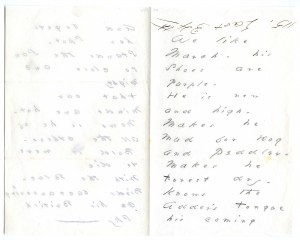Amherst College: Emily Dickinson Collection

To say Emily Dickinson has an association with Amherst College is a bit of an understatement. Her grandfather, Samuel Fowler Dickinson, was one of the founders of the college and her father, Edward Dickinson, was treasurer of the school for over 35 years. In 1956, Millicent Todd Bingham gave Amherst College the Dickinson poems and Dickinson family papers she inherited from her mother, Mabel Todd Bingham. Many of these wonderful materials were digitized for this fine collation, and lovers of poetry and American literature will find this entire collection to be a real delight. Visitors to the site will find 850 documents here, including drafts of poems like “Further in summer than the birds” and “On that Specific Pillow.” Visitors can search the collection by genre, contributor, subject, or date range. After selecting a particular item, visitors can also zoom in and out as they see fit to get a sense of Dickinson’s handwriting and creative process.
From The Scout Report, Copyright Internet Scout 1994-2013. https://www.scout.wisc.edu/
10 Classic Books You Read in High School You Should Reread
Kevin Smokler is the author of Practical Classics: 50 Reasons to Reread 50 Books You Haven’t Touched Since High School. Here he describes how, in rereading these 10 high school classics, he “found that useful thing I missed the first time around”:
- The Great Gatsby by F. Scott Fitzgerald
- The Adventures of Huckleberry Finn by Mark Twain
- The Age of Innocence by Edith Wharton
- To Kill a Mockingbird by Harper Lee
- Fahrenheit 451 by Ray Bradbury
- The Stranger by Albert Camus
- The Metamorphosis by Franz Kafka
- the poems of Emily Dickinson
- The Crying of Lot 49 by Thomas Pynchon
- Animal Farm by George Orwell
Smokler also provides the list in the next item.
Genre Kryptonite: Novels of Female Friendship
While definitely asserting his guyness, Kevin Smokler (see above) explains why he has learned a lot from these novels of friendship between women:
- Waiting to Exhale by Terry McMillan
- Sula by Toni Morrison
- the Sisterhood of the Traveling Pants series by Ann Brashares
- How To Make an American Quilt by Whitney Otto
- Girls in Trucks by Katie Crouch
‘God, Let Me Be Loved’: The Tragedy of Truman Capote
In all of American letters there is no tale sadder than the biography of Truman Capote. A true prodigy, Capote was publishing stories in national magazines by his early twenties, and published his first novel at age 24. After dabbling in writing for the theater and the movies, he returned to prose, first with the classic 1958 novella Breakfast at Tiffany’s, and then eight years later, his masterpiece, the “nonfiction novel” In Cold Blood, about the senseless killing of a Kansas farming family.
And then…nothing, or very near to it.
Michael Bourne writes an appreciation of the quixotic Truman Capote. About why Capote doesn’t get the critical respect he deserves, Bourne writes:
Ultimately, though, the damage to Capote’s literary reputation is mostly self-inflicted. True, he wrote two genre-defining works, Breakfast at Tiffany’s and In Cold Blood, along with some truly great stories, including the heartbreaking “A Christmas Memory.” But he could have done so much more. Capote is hardly alone in coming to a sad end. Ernest Hemingway shot himself in despair; Tennessee Williams, a contemporary and close friend of Capote’s, choked on a bottle cap after more than twenty years of creative failure. But they got their major work done. Capote didn’t. Yet for all this, he remains worth reading because unlike most self-deceiving people he was also a genius, and part of that genius was a capacity to look honestly at his own deceptions, even if in life he couldn’t help being misled by them.
As Good as It Gets: Nominations for Best Film About a Writer
“Writers like watching movies about themselves,” writer Roger Rosenblatt announces. But:
What we are not shown doing in movies is writing. Composers are shown composing because we can listen to their flights of fancy on the soundtrack. Painters are shown painting, because one can actually see art in progress. Kirk Douglas did some very good van Gogh impressions. Ed Harris went so hog wild in “Pollock,” one was tempted to go out and buy an original Harris. But writers are rarely shown laboring at the craft unless you count Nicholson’s “all work and no play.” I suppose there’s nothing visually dramatic in what we do, though we can get quite worked up about crumpling little balls of paper, tossing them on the floor, then turning our heads this way and sometimes that.
Nonetheless, Rosenblatt discusses several films about writers before choosing these three winners:
- The Third Man (1949)
- Starting Out in the Evening (2007)
- Breakfast at Tiffany’s (1961)
